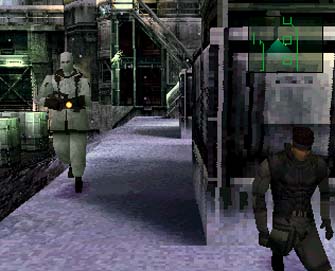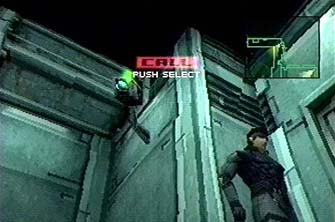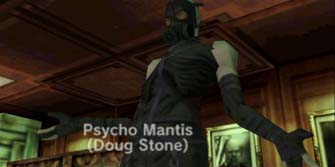 Solid Snake is retired. At least, he thought he was. The threat of a terrorist nuclear strike should be enough to get anyone back in the office, even when ‘the office’ is a submarine torpedo tube and the first appointment of the day is the unarmed infiltration of a vast weapons disposal facility crammed to the brim with genetically enhanced soldiers. This is business as usual for Solid Snake. His objectives are to liberate two key hostages and assess the strength of the nuclear threat, but between him and his goals stand the ruthless and skilled members of his old Special Forces unit: FOX-HOUND.
Solid Snake is retired. At least, he thought he was. The threat of a terrorist nuclear strike should be enough to get anyone back in the office, even when ‘the office’ is a submarine torpedo tube and the first appointment of the day is the unarmed infiltration of a vast weapons disposal facility crammed to the brim with genetically enhanced soldiers. This is business as usual for Solid Snake. His objectives are to liberate two key hostages and assess the strength of the nuclear threat, but between him and his goals stand the ruthless and skilled members of his old Special Forces unit: FOX-HOUND.
The third in a series of games previously released for the MSX and the brainchild of Hideo Kojima, Metal Gear Solid was intended from its conceptualization to be the ‘best PlayStation game ever’. Kojima initially trained in film, and announced his intention to make a career in videogames three years into college. Perhaps it was this cinematic influence, perhaps it was his difference in approach, but Kojima’s games have always been held up as shining examples of their genres; in the 80s he broke the trend and produced a stealth game in a market flooded with industry-standard shooters. The hype surrounding Metal Gear Solid 4: Guns Of The Patriots is proof that even after twenty-one years of Metal Gear, the man still has serious cache.
I’ve been playing video and computer games since I was knee high to a grasshopper, but I’ve never played a Metal Gear game before. So as the excitement for MGS4 rages on, here at VGB I’ll be reviewing the series as I play them through for the first time. What’s all this hype about?
System: PlayStation, PC
Genre: Stealth, Action
Released: October 21st 1998 (US), February 26th 1999 (EU)
Players: 1
Developer: Konami
Publisher: Konami
Memory Card: 1-2 Blocks (each picture uses additional 2 Blocks)
Country of Origin: Japan
Here’s a Metal Gear Solid trailer from 1997:
From the very beginning it is clear that the ambitions for Metal Gear Solid are huge. Enormous. The cinematic opening alone, where Solid Snake’s briefing is heard as we watch him deployed from a submarine, is brilliantly sequenced and, for want of a better word, shot. The camera angles, lighting and underwater effects perked me up from the slightly cynical frame of mind in which I usually begin playing 10 year old games. I became excited.
Solid Snake surfaces in a docks area, unarmed and equipped only with a few smuggled cigarettes. It is up to him to stealthily avoid capture, find weapons, and complete his objectives.

Knock Knock…Who’s There?
Shadow Moses – the base – has been taken over by FOX-HOUND and their genetically enhanced GENOME soldiers. Solid Snake is equipped with a radar device that shows the location and cone of vision of the GENOME soldiers, allowing him to neatly avoid them if you wish – essential when he first enters the base unarmed.
The controls are smooth and adapt well to different styles of play – fast darting responses or slow, cautious advances are equally well served by the control sensitivity. I think MGS was intended for use with the first PlayStation controller – using the Dual Analog or Dualshock sticks can lead to some unintended actions – this is definitely a game where you should stick to the D-pad and stay there, but the Dualshock’s vibration adds several nice touches.
The graphics and level design are astounding, considering the age of the game (10 years!) and the 32 bit PlayStation platform with its 33MHz processor. In 1998 it was revolutionary, and even today it looks like a later-gen game with the polygon count, pixel resolution and color palette reduced. The environments are fully rendered and the first person view and zooming scope enables a leisurely perusal of your whereabouts before you decide on a plan of action, which in outdoor and enemy-packed surroundings is a prudent tactic. The dynamic detail is something special as well. Shadow Moses is located in Alaska and when outdoors Snake’s breath hangs in the cold air, and he leaves footprints in the snow that slowly fill with fresh fallen flakes. If a guard happens across the prints before they’re covered, his curiosity is aroused and he’ll follow them to find the source. Leaping foes will spray snow, water and office papers around them, the particle effects are sparse but incredibly effective, and the extent to which Solid Snake can interact with his surroundings with equipment and his body is breathtaking for the game’s age.

Peekaboo
While the 3D game looks drastically different from the earlier 2D titles released in 1987 and 1990, the plot is continuous, which means there’s a lot of backstory the player has to be made aware of, and the clumsy way this was introduced made me roll my eyes a little. There’s a phrase used to describe that sort of painfully blatant backstory presentation: it’s as if at the beginning of an historical drama a man walks up to a prince and says, “As you know, your father, the king…” – it’s essential detail, yes, but produced out of context and hence feels unreal. Solid Snake does not need to be told that FOX-HOUND is his old unit, or that his CO on this mission – Colonel Campbell – used to command them. The player needs to know, but I for one would have been happier finding out if Campbell mentioned it in passing rather than declaring it outright – subtlety in this regard doesn’t shake the player back into the real world so jarringly. That said, the plot is deep and interesting, with surprising revelations and more than a couple of twists. It’s played out through communication with other characters via CODEC, or a radio-based videophone device using different frequencies to get in touch with different people, and cutscenes at vital moments are animated using the game’s 3D engine. I have to say – I was surprised at the quantity and quality of speech. I was under the impression that PlayStation games, and especially ones of this size, had to fight for space on game discs, but while the cutscene and CODEC dialogs do deliver vital information, they also wander in and out of tangentially relevant subjects; morality, genetics, Japanese anime, Chinese proverbs, the history of nuclear weapons, and even the habits and behavior of Alaskan field mice. While all of these topics are plot related to some extent and the collection of background detail and depth of story is unparalleled, there is no urgency to the information dispensed in this way, and it can get a little repetitive. You can be in the most emotionally charged moment, where a discussion ranges over crucial plot twist, backstory and objective changes, and details are repeated and stated in different ways, and then afterwards as you’re raring to get started, your CODEC will ping and Colonel Campbell will restate what was just discussed. I started off with an open mind, but after a while this began to test my patience. For a condensed overview of Metal Gear Solid‘s plot, check out this Videogamesblogger post post for a 20 minute potted version.

Better Set Your Phone To Vibrate
FOX-HOUND is no ordinary special forces unit. Sick of doing the government’s bidding, they’ve gone rogue, and these powerful individuals bar your path, each with different abilities and weapons. You’ll meet the pistol-toting ‘Ricochet Genius’ Revolver Ocelot, there’s heavy weapon shaman Vulcan Raven, the eerie telekinetic mind reader Psycho Mantis, wily master marksman Sniper Wolf, and Decoy Octopus – a mysterious agent referred to but never openly seen…and finally their leader who holds the same codename as our hero – Liquid Snake. In addition to the rogue members of FOX-HOUND, there is also a ghostly, fleeting character wielding a blade whose slashing attacks seem to be terrorizing the terrorists themselves…
Each of these enemies faces Solid Snake in one or two boss battles as he progresses through the base and closer to Metal Gear REX, the mobile missile launch platform the terrorists are planning to use to launch their nuclear strike. The methods required to outwit and take out the bosses vary brilliantly, pushing the impressive selection of equipment to the limit and beyond, forcing the player to use the game environment, timing, skill, and even the game controller and console as direct tools on the path to victory. I was completely unprepared for the destruction of the ‘fourth wall’ in this way. When the CODEC chimed and I was told that I had to do something – not Snake in the gameworld but me, in my chair, in front of the television – after the panic subsided, I was incredibly impressed.

Psycho Mantis: Surprisingly Perceptive
The long cutscenes, extensive dialog and the fact that the game’s creator is billed as the ‘Director’ mean I’m bound to address the game’s cinematic approach. There is a lot to take from Metal Gear Solid. The cinematography is first-rate. Camera angles are never dull, the action is coolly framed and exciting, and even during the longest expositional monologues the views switch to an arty shot of the scene in a mirror, a scene-setting sweep, or a related full-motion video on the topic in question. If the lengthy cutscenes were occasionally frustrating to me I think it might be because I am simply not used to them. Not just because I might be used to faster paced en-route plot of modern games, but because Metal Gear Solid represents a true blend of cinema and videogames, which takes an adjustment of anticipated pace and a little more patience from the player; something I wasn’t quite prepared for. The rewards are there, if you want them, in the form of an exceptionally information-rich, deep gaming experience, the bulk of which sadly occurs outside of the flow of the game, in cutscenes and CODEC dialog. But this is a 1998 PlayStation game we’re talking about here – that this experience exists at all is a technical and artistic triumph.

Virtual Reality Training Missions
In retrospect I think the game is a clear transition from its predecessors of the 2D run-and-shoot oeuvre (or run-hide-shoot) and the more fleshed-out 3D worlds of today. Metal Gear Solid cries out to have an over-the-shoulder third person view, rather than the lid-off-the-building perspective it has. In the evolution of videogames, the lid-off view combined with the occasional first-person peek is a transitional point from those 2D top-down games to the more complex 3D games where the camera is automatic or controlled by the player. The play style also harks back to less free-roaming games – at many stages of the game there is only one single path of action that yields a viable result…or in fact any result at all. The bosses all take specific methods to beat them, and they’ll either hint at the method themselves, your CODEC will handily chip in and the Colonel will give you some tips, or you’ll be there cycling through your weapons at the start of a long trial-and-error session. It reminds me of the days when I would get stuck on something at home and then ask around at school to see if anyone knew how it was done. You can’t progress far in Metal Gear Solid without a weapon, yet the first gun is very easily missed…at least I missed it to begin with.
Fun Factor: 7.5
This was a tough call, not least because I know it will be an unpopular one. Scores are entirely based on personal taste. While the gameplay was entertaining, challenging and at times eye-openingly refreshing, the repeated interruption of that enjoyable play with the CODEC and long, meandering cutscenes gradually became annoying and they wandered just a little too far off topic to retain my interest. Another slight peeve I have is the ‘translated’ feel to a lot of the dialog and character names. Do you know what an Ocelot is? It’s the jaguar’s cute effeminate cousin. I have difficulty facing off against a bad guy named after something cute enough to make my wife want to take it home. In the first two hours of gameplay Solid Snake hits on both his female handlers and a girl he meets inside the base who happens to have such a distinctive walk that it turns into a crucial plot point, and her bottom has its own dedicated cutscene. James Bond might be a philandering womanizer, and yes the female characters have their strengths, but this sequence of events struck me as misogynistic.
I don’t want to spend all of this section justifying the 2.5 I knocked off – Metal Gear Solid is unquestionably a great game; a truly landmark title. I just didn’t enjoy it enough to rave about it.
Graphics: 10
The graphics are phenomenal. The kind I’m sure other PlayStation developers were cursing at the time for raising the bar so high. Even ten years later this game has serious integrity and shines out from the entire spectrum of PlayStation games.
Audio: 9.5
The electronica/classical music themes change and accelerate with the pace of the game, the sound effects are realistic and change depending on the environment they occur in – internal shots echo, external ones do not – and the theme tune and other standard themes have formed an unmistakable imprint on my mind. There’s no denying that the audio signature of the game is unique and special.
Ingenuity: 10
Again, there’s little here that didn’t rewrite the book on how games could be played. The sheer volume of story can still teach a thing or two to would-be games writers out there, the complexity and interactivity of the environment and tools was groundbreaking and holds up even today.
Replay Value: 7
Around the time of its release the sheer breathtaking novelty of all that goes to make up Metal Gear Solid would warrant multiple plays. Today, the finer details of the plot might lure you in for another round. That or the challenge of trying the game on the harder difficulties, which include removal of radar and increased damage from enemy bullets.
Next in the series, 2001’s PlayStation 2 sequel, Metal Gear Solid 2: Sons Of Liberty.
